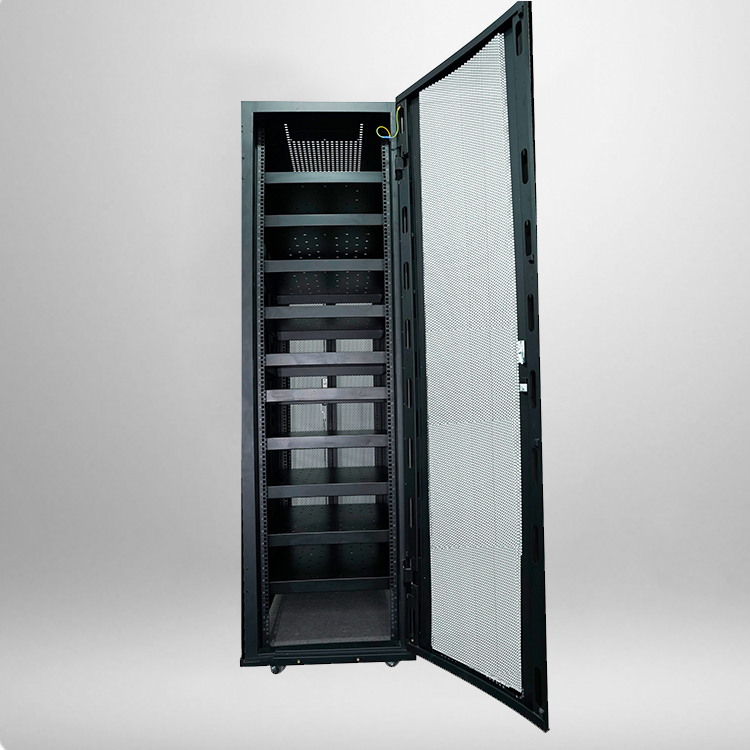
What Do You Put in a Network Server Cabinet?
Network server cabinets are the backbone of modern IT infrastructure, housing critical components that enable data processing, storage, and communication. A well-designed server cabinet optimizes space, cooling, security, and accessibility, ensuring reliable operation in environments ranging from small offices to large data centers. This paper explores the essential components, layout principles, and best practices for equipping a network server cabinet, with a focus on functionality, efficiency, and scalability.
1. Introduction
A server cabinet, also known as a rack enclosure, is a structured framework designed to organize and protect network equipment. It typically consists of vertical mounting rails (e.g., 19-inch racks), adjustable shelves, and ventilation systems. The contents of a server cabinet depend on the organization’s needs, but common elements include servers, switches, routers, storage devices, power distribution units (PDUs), and cooling systems. This paper outlines the key components and considerations for building a functional server cabinet.
2. Core Components of a Server Cabinet
2.1 Servers
Servers are the primary workhorses of a cabinet, handling data processing, application hosting, and cloud services. They vary in form factor:
1U/2U Rackmount Servers: Space-efficient units for general computing tasks.
Blade Servers: Modular systems with shared resources (e.g., power, cooling) for high-density deployments.
Tower Servers: Standalone units used in small-scale setups but less common in rackmount configurations.
2.2 Networking Equipment
Network devices enable connectivity and data transfer:
Switches: Connect multiple devices within a local area network (LAN). Managed switches offer advanced features like VLANs and Quality of Service (QoS).
Routers: Direct traffic between networks and provide internet access.
Firewalls: Protect against cyber threats by filtering incoming and outgoing traffic.
Network Interface Cards (NICs): Expand connectivity for servers.
2.3 Storage Systems
Storage solutions are critical for data retention:
Hard Disk Drives (HDDs): High-capacity, cost-effective storage for non-urgent data.
Solid-State Drives (SSDs): Faster, more reliable storage for performance-sensitive applications.
Network-Attached Storage (NAS): Shared storage accessible over the network.
Storage Area Networks (SANs): High-speed storage networks for enterprise-level data management.
2.4 Power Management
Reliable power distribution is essential:
Power Distribution Units (PDUs): Distribute power to devices, often with surge protection and monitoring.
Uninterruptible Power Supplies (UPS): Provide backup power during outages to prevent data loss.
Circuit Breakers: Protect against overloads and electrical faults.
2.5 Cooling Systems
Effective cooling prevents overheating:
Fans and Blowers: Circulate air to dissipate heat.
Air Conditioning Units: Maintain optimal temperatures in large cabinets or data centers.
Cold Aisle Containment: Separates cold and hot airflows to improve efficiency.
2.6 Cabling and Management
Cables connect devices and require organization:
Ethernet Cables (Cat5e, Cat6, Fiber Optics): High-speed data transmission.
Power Cords: Supply electricity to devices.
Cable Management Tools: Tray, clips, and labels to reduce clutter and improve airflow.
2.7 Monitoring and Security
Tools for oversight and protection:
Environmental Sensors: Monitor temperature, humidity, and airflow.
IP Cameras: Secure the cabinet physically.
Remote Management Cards: Enable remote troubleshooting and updates.
3. Layout and Design Principles
3.1 Space Utilization
19-Inch Standard: Most equipment adheres to the EIA-310-D standard, ensuring compatibility.
Height Units (U): Servers and devices are measured in “U,” where 1U = 1.75 inches. Optimize vertical space by grouping similar devices (e.g., all servers in the lower half).
3.2 Airflow Management
Front-to-Back Cooling: Align devices so intake vents face the cold aisle and exhaust vents face the hot aisle.
Ventilation Grilles: Install perforated doors to enhance airflow.
Avoid Overcrowding: Leave gaps between devices to prevent heat buildup.
3.3 Cable Management
Vertical and Horizontal Cable Trays: Route cables neatly to avoid tangling.
Color-Coding: Use different colors for power, data, and management cables.
Labeling: Clearly mark cables for easy identification.
3.4 Redundancy and Scalability
Dual Power Feeds: Connect PDUs to separate power sources to avoid downtime.
Modular Design: Choose scalable components (e.g., blade servers) to accommodate future growth.
4. Case Studies
4.1 Small Office Setup
Components: 2U server, 1U switch, 1U NAS, 1U UPS, and basic cabling.
Layout: Servers and storage at the bottom for stability, networking gear at the top.
Cooling: Built-in fans and a single exhaust fan.
4.2 Enterprise Data Center Cabinet
Components: 10x 1U servers, 2x 2U switches, SAN storage, redundant PDUs, and environmental sensors.
Layout: Cold aisle containment with hot air exhausted to a centralized cooling system.
Security: Biometric locks and real-time monitoring via a management dashboard.
4.3 High-Density Cabinet
Components: Blade servers, high-speed fiber switches, liquid-cooled storage arrays.
Cooling: Rear-door heat exchangers and chilled water systems.
Power: Three-phase PDUs with power monitoring for energy efficiency.
5. Best Practices and Standards
5.1 Compliance
EIA-310-D: Standardizes rack dimensions and mounting interfaces.
ASHRAE Guidelines: Define acceptable temperature and humidity ranges for data centers.
NFPA 75: Ensures fire safety in IT equipment rooms.
5.2 Maintenance
Regular Cleaning: Dust accumulation can impede cooling.
Firmware Updates: Keep devices secure and optimized.
Load Testing: Verify power and cooling capacity during peak usage.
5.3 Energy Efficiency
Energy Star Certified Equipment: Reduce power consumption.
Variable-Speed Fans: Adjust airflow based on demand.
6. Conclusion
A network server cabinet is a dynamic ecosystem requiring careful planning to balance performance, reliability, and cost. By integrating servers, networking gear, storage, power management, and cooling systems while adhering to industry standards, organizations can create scalable and efficient infrastructure. As technology evolves—toward higher densities, edge computing, and AI-driven applications—the design of server cabinets will continue to adapt, prioritizing innovation and sustainability. Properly designed cabinets not only support current operations but also future-proof investments in an increasingly data-centric world.


